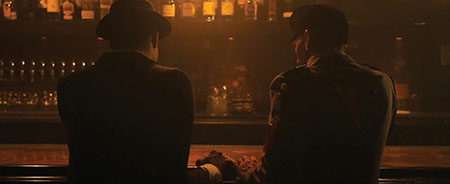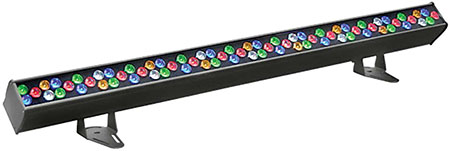The Versatility of LEDs: RGB, DMX
As most of us are experiencing new lighting technology, physical gels are slowly becoming obsolete with new LEDs. They’re obviously essential when balancing sources on location and other HMIs or tungsten Fresnels in your package. However, now we have LED units with RGB-emitting capabilities where we can dial in any color we want and the light will produce it. You can also dim some units without changing color temperature, which you could not do on a lot of older units where you would start to get a warmer color when dimming down.

The recent movie “Never Stop” was filmed using LEDs.
I recently filmed “Never Stop” during which we lit everything with LEDs. I could only use what we had access to, so I had a mix of Kino Flo Selects and a variety of lights from the theater scene that typically aren’t used in cinema. These included Chauvet COLORado Battens, Martin Mac Auras and ETC Source Four Lustr 2 units, all of which included DMX and RGB capabilities.
These ended up serving me well as I had to create a post-apocalyptic world with vibrant parties and underground bars, and I had to do it quickly. Without delay my gaffer could dim every unit and change the colors and frequencies as we went, which made for fast auditions through different looks.
COLOR FLEXIBILITY
What is great about the flexibility in the color of LED lights with RGB is the fact that you can easily match practicals in the space. For this film, I could meter color and then dial in the exact hue on whatever light I was using, with really nice color rendering.

ETC Source Four LED Series
Sometimes you don’t have control over practicals and can’t replace bulbs or fixtures so being able to match the available light in the space so easily is a plus. You don’t always catch green and magenta coming out in your units either, so having control over that axis is very important and so easy now.
In the unique bar location for “Never Stop,” we had almost urban vapor-colored practicals. I have plenty of urban vapor gel, as it’s my favorite, but it wasn’t quite matching. Being able to be precise with the RGB modes on the LEDs made it easy to get everything looking like it was coming from the same sources in the space.
I would have to say my favorite light I had was the ETC Source Four LED. The original Source Four tungsten Fresnels are wonderful—I could light a whole scene with them and I’m sure I have in the past. Now I had the directionality and efficiency of a traditional Source Four with the added ability to make it whichever color I wanted with the click of a button.
Another great thing is that with the narrow beam, I didn’t have to flag any walls off or shape them with anything except for their internal blades. The Source Four LEDs were also rigged very high up on beams of a loft space, so having to go up to audition a gel would have taken time. Because these have DMX, a digital communication network that allowed us to talk to the units through software on our laptop, we were able to change color, intensity and frequency from the ground.
It’s interesting gaining a handful of units that aren’t what you’re used to, but new LEDs are opening up a whole new game in terms of possibilities and efficiency. You’re able to audition more options in a shorter amount of time, and understanding DMX communication and setup is becoming crucial.

Chauvet COLORado Batten
Even with the Kino Selects, which we just controlled from the back of the units, we were able to dial in things quickly. With apps such as Gel Swatch Library, you can look up more than 1,000 of your favorites from manufacturers like Lee and Rosco and then plug in RGB percentages on your LED.
If you have something like a Select, you do so on the back; and if you have LEDs all set up with DMX, you can do so through whatever program you are using on a laptop.
As I always suggest, the best way to decide which units you like and which are the most accurate when it comes to color temperature and tint is to test them yourself and talk with other cinematographers and gaffers about what they have used. We have countless options when it comes to light and color. Getting out there and playing with the wonderful tools we have will do nothing but enable you to better prepare yourself for the next project.
Julia Swain is a cinematographer based in California, whose narrative films include “Killing Animals,” “Jilted” and “Cassidy Red.” She continues to shoot on a variety of formats, seeking to create compelling visuals for every story and brand. She can be contacted via Twitter: @JuliaSwain or through TV Technology.
Get the TV Tech Newsletter
The professional video industry's #1 source for news, trends and product and tech information. Sign up below.
